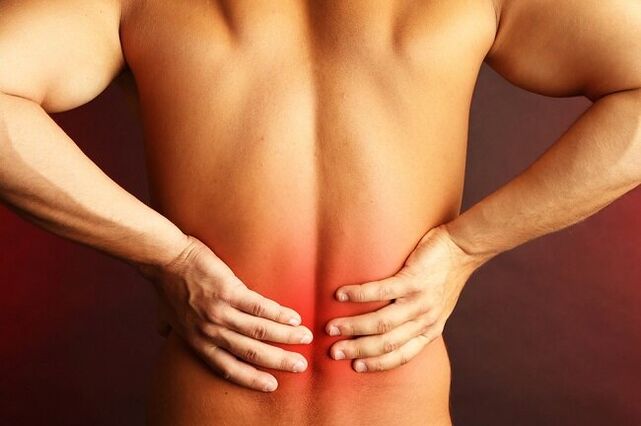Low back pain is one of the worst conditions imaginable, since the lumbar spine is the most stressed compared to the rest of the spine, which is why the lower back is the most susceptible to injury. Back pain is most often a symptom of osteochondrosis, as well as radiculitis and other serious illnesses.

Why does the lower back hurt
Most of the time, lower back pain occurs after intense training, as well as if you stay in the same position for a long time or because of an awkward movement. The main risk factors due to which low back pain can appear:
- driving constantly or because of a sedentary lifestyle, working at a computer;
- if work is associated with a constant load on the lower back, stress;
- excessively intense workouts in the gym;
- also possible low back pain due to pregnancy or recent childbirth;
- great weight.
Lower back pain usually goes away on its own when you leave it alone. If, however, the lower back hurts constantly or pain periodically appears, this may already be a sign of the disease. Without the right treatment, back pain can lead to very serious consequences - including spinal surgery.
What Illnesses Can Cause Lower Back Pain
Low back pain is divided into primary and secondary. Primary pain syndrome directly causes spinal disease:
- in most cases it can be osteochondrosis of the lumbar spine (one third of all cases);
- it can also be an intervertebral hernia;
- intervertebral disc protrusion;
- spondylolisthesis, spondylosis, spondyloarthrosis.
Secondary pain syndrome usually occurs not because of the spine, but because of some other problems in the body that cause low back pain:
- may be fractures due to osteoporosis;
- tumors in the lumen of the spinal canal;
- spinal fracture;
- prolonged stay in one position and constant muscle load;
- anatomically narrow spinal canal;
- scoliosis, kyphosis, kyphoscoliosis, Scheuermann-Mau disease;
- it can also be rheumatoid arthritis or psoriatic arthritis or osteoarthritis;
- osteomyelitis, discitis, spinal tuberculosis;
- it also hurts can cause urolithiasis;
- pyelonephritis;
- recent pregnancy or childbirth;
- ovarian cancer, ovarian cyst, endometriosis.
What to do for back pain
What to do if you have severe back pain, we recommend:
- lie on your back or on a hard mattress, a surface that would support your lower back;
- lift your legs and bend your knees, you can put a pillow under your feet to make it much easier to lie down;
- taking painkillers or anti-inflammatory drugs;
- try not to make any sudden movements;
- call a doctor to your home;
- for several days you need to stay in bed;
- it is worth giving up spicy and smoked foods, in addition to adhering to proper nutrition.
Prophylaxis
In order to avoid such problems, you need to constantly take preventive actions:
- less sedentary lifestyle;
- if you still have sedentary work, try to do a little exercise every hour - tilt your head and torso to the sides, roll your shoulders back and forth, spread your legs shoulder-width apart, and inhale and exhale;
- if you lift weights, do it well - keep your back straight, don't make sudden movements, lift the weights gradually;
- do more spine and abdominal exercises;
- pay attention to posture, keep your back straight, do not bend over, sit down and preferably walk with a book on your head;
- give up on a bed and soft mattresses - choose not the softest but also the hardest so that it supports your lower back well;
- several times a day, stay close to the wall so that your heels, buttocks, shoulder blades and also the back of your head touch it, stay like that for several minutes;
- do more sports that keep your back muscles in good shape, such as swimming, hiking, skiing, yoga, and so on;
Therapeutic gymnastics for the treatment of the lower back in men and women
If the low back pain is minor, to avoid it, do the following exercises:
- Lie on your back, stretch your arms along your torso and bend your legs slightly at the knees. Bend your legs to the left side and turn your head and torso slightly to the right. Hold for a few seconds. Then return to the starting position and repeat the exercise by bending your legs to the other side. Do this exercise 10 times.
- Get on your knees. Place your hands on the chair in front of you. In this position, bend your back up and then bend as much as possible. Repeat the exercise 5-10 times.
- Lie on your back and straighten your legs. Then lift your right leg 20 centimeters off the floor. Keep this up until you feel tired. Do the same exercise with the other leg. Repeat this exercise 5 times on each leg.

















































